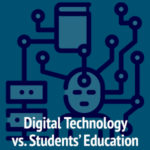
When Mark Twain said, “I never let my schooling get in the way of my education” he was distinguishing between the effects of the conventional, institutional practices associated with schools, and the individual human endeavor—a life-long exercise—to become an educated person. But what does education consist of?
Schooling vs. Education
At its core, “education” is the accumulation of knowledge and skills, and of course, moral/ethical values. (See Education) In complex societies—those in which person-to-person informal, intergenerational transmission of skills and knowledge is insufficient to ensure that successive generations acquire such assets—formal, structured schooling has been the form that education has taken. Throughout the history of Western society, much education has been conducted in private settings (e.g., tutors, private schools, monasteries, etc.) In ancient Greece, for example, private schools and academies were tasked with educating the young free-born Athenian. During the Middle Ages, most schools were founded upon religious principles with the primary purpose of training clergy. Following the Reformation in northern Europe, clerical education was largely superseded by forms of elementary schooling for larger portions of the population. The Reformation was associated with the broadening of literacy, primarily aimed at equipping people to read the Bible and experience its teachings directly. It wasn’t until the 19th century, however, that the idea of educating the mass of a nation’s population via universal, non-sectarian public education emerged in Europe and the U.S.
In 1821, Boston started the first public high school in the United States. By 1870 all of the US states had some form of publicly subsidized formal education. By the close of the 19th century, public secondary schools began to outnumber private ones. Access to schooling has been a perennial challenge, with women slowly gaining access throughout the 19th and early 20th centuries, and African Americans largely excluded from schooling or relegated to sub-standard schooling. By 1900, 34 states had compulsory schooling laws and thirty states with compulsory schooling laws required attendance until age 14 (or higher). By 1910, 72 percent of American children attended school, and half the nation’s children attended one-room schools. It was not until 1918, a little over a century ago, that every state required students to complete even elementary school.
Throughout its history, schooling has served many purposes. From the beginning of American public schooling, its purposes and goals have been fiercely contested. Some viewed schools as civic and moral preparatory institutions, while others saw schools as essential to forging and consolidating a distinct US national identity. Many saw schools as critical socializing processes which were designed less for the intellectual development of individuals, and more for equipping an increasingly industrializing workforce with the habits of, and tolerance for, factory work.
Factory Schools
In a recent article “The Modern Education System Was Made to Foster “Punctual, Docile, and Sober” Factory Workers Perhaps it’s time for a change.” Allison Schrager argues that 19th century American education was designed to produce disciplined, dependable, and compliant workers for an expanding industrial economy. Industrialists (often in alliance with other social sectors, like the Protestant clergy and later social reformers) believed that young people (many of them traditionally involved in agriculture, many the offspring of immigrants to the US) needed to be readied for factory life—which demanded punctuality, regular attendance, narrow task orientation, self-control, and respect for authority. These characteristics, although instrumental for an industrializing economy, were hardly geared toward the development of autonomous, self-directed individuals, and active democratic citizens. The “factory model” of schooling was functional, but by many accounts, stunting. This factory model, Schrager argues, remains widely prevalent in contemporary US schools. (For a critique of the reign of factory model of schooling see, Valerie Strauss, “American schools are modeled after factories and treat students like widgets. Right? Wrong.” Washington Post, Oct. 10, 2015 ) Schrager argues that the factory model is anachronistic and increasingly dysfunctional.
As mentioned, education is always a “contested terrain.” Various social, economic, political, and religious forces are interested in ensuring that schools teach what representatives of these forces value. Consequently, the content, and in some cases, the form, that schooling takes is the product of the struggle among these forces. (See for example our earlier article, “The Implications of Public School Privatization” Part 1 and Part 2 )
Underlying all forms of schooling, public and private, are the implicit questions, “What is education?” and “What is education’s purpose?” In a forthcoming article, we’ll explore these central questions.
Resources:
History of Education in the U.S.
Valerie Strauss, “American schools are modeled after factories and treat students like widgets. Right? Wrong.” Washington Post, Oct. 10, 2015
Allison Schrager, “The Modern Education System Was Made to Foster “Punctual, Docile, and Sober” Factory Workers Perhaps it’s time for a change.”





